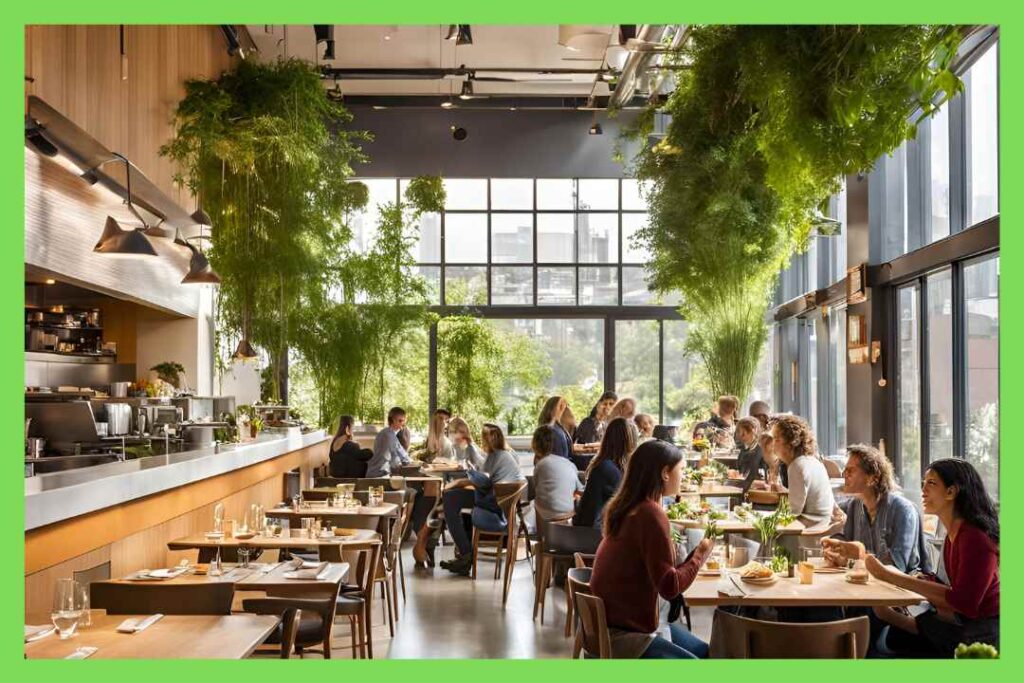As diners become more aware of their choices, you might wonder: how crucial is the environmental impact when choosing a place to eat? In today’s world, eco-friendly restaurants are not just a trend; they represent a significant shift in consumer behavior towards sustainability. Understanding why restaurants should adopt these green practices reveals both the benefits of sustainable practices for the planet and the financial advantages they offer.
Embracing eco-friendly initiatives can attract a new wave of eco-conscious customers and enhance the overall image of dining establishments. It’s time to explore the imperative of becoming a green dining establishment and the ripple effects it can create for the food industry.
The Rising Importance of Eco-Friendly Practices in Restaurants
Environmental worries are growing, and the restaurant world is taking notice. More people want to eat at places that care about the planet and society. This has made eco-friendly dining a key focus for restaurants.
Using green methods can really help a business grow. For example, buying food from local farms shows a restaurant’s dedication to the environment. It also helps the local economy and cuts down on food transport emissions. Plus, using less energy is a big step towards being more eco-friendly.
Restaurants that care about the planet work hard to reduce waste. They compost and recycle, making dining more enjoyable for everyone. By doing this, they attract customers who value the environment. It’s a win-win for both the restaurant and the planet.
| Eco-Friendly Initiative | Description | Benefits |
|---|---|---|
| Sourcing Local Ingredients | Using ingredients grown or produced within a local area. | Supports local farmers, reduces carbon footprint, enhances freshness. |
| Energy Efficiency | Implementing energy-saving appliances and practices. | Reduces utility costs, lowers greenhouse gas emissions. |
| Waste Management | Utilizing composting and recycling methods for waste disposal. | Minimizes landfill contributions, promotes a circular economy. |
Understanding the Environmental Footprint of the Food Industry

The food industry’s environmental footprint is a big problem for our planet. Restaurants, being a key part of this industry, have a big impact. They are a major source of greenhouse gas emissions, mainly because of how we produce and consume food.
Working together, we can make a difference. Restaurants can start by using less energy and reducing waste. This can help lower their carbon footprint.
By using local ingredients, restaurants can cut down on emissions from transportation. This also supports local farmers. Energy audits can help find ways to use less energy and be more efficient.
Managing waste is also crucial. Reducing food waste saves resources and money. It also cuts down on methane from landfills. Restaurants can teach their staff about sustainability and plan better to reduce waste.
| Impact Area | Current Status | Opportunity for Improvement |
|---|---|---|
| Energy Consumption | High; inefficient equipment | Conduct energy audits, upgrade technology |
| Food Waste | 30-40% of food supply wasted | Implement portion control, donation programs |
| Sourcing | Primarily non-local ingredients | Focus on local, seasonal produce |
| Water Usage | Overconsumption in food prep | Utilize water-saving technologies |
By taking these steps, restaurants can help solve the environmental problems in the food industry. Going green is not just a duty; it’s a chance for restaurants to stand out in a market that cares about the environment.
Why should restaurants be eco-friendly?

Restaurants can greatly benefit from being eco-friendly. This is especially true for tackling two big issues: high energy use and waste. By using energy-saving methods, restaurants can cut down on their environmental impact.
Addressing High Energy Consumption
Restaurants often use a lot of energy, which can be costly. Using energy-efficient appliances and LED lights helps lower energy use. Adding solar power can also reduce the need for non-renewable energy.
Regular energy audits are key. They help find ways to use less energy and keep improving.
Reducing Food and Water Waste
It’s important for restaurants to cut down on food and water waste. Good inventory management helps avoid buying too much. Using portion control ensures customers get just the right amount, reducing leftovers.
For water, simple changes like installing low-flow faucets make a big difference. By focusing on these areas, restaurants help the environment and save money too.
| Strategies | Focus Area | Expected Outcome |
|---|---|---|
| Energy Audits | High Energy Consumption | Identify inefficiencies and reduce costs |
| LED Lighting | High Energy Consumption | Lower energy bills and enhanced ambiance |
| Low-Flow Faucets | Reducing Food and Water Waste | Significantly lower water consumption |
| Inventory Management | Reducing Food and Water Waste | Minimized food waste through effective tracking |
Benefits of Sustainable Practices for Restaurants
Restaurants gain a lot by adopting sustainable practices. These efforts not only cut costs but also attract eco-friendly customers. By focusing on sustainability, restaurants can improve their reputation and keep customers coming back.
Cost Savings through Energy Efficiency
Using energy-efficient tech can greatly reduce utility bills. Upgrades like LED lights, modern HVAC, and energy-saving appliances are key. Here’s a look at how these changes can save money:
| Upgrade | Initial Investment | Estimated Annual Savings | Payback Period |
|---|---|---|---|
| LED Lighting | $2,000 | $400 | 5 years |
| High-Efficiency HVAC | $10,000 | $1,200 | 8 years |
| Energy-Efficient Oven | $5,000 | $600 | 8.3 years |
| Insulated Refrigeration Units | $3,500 | $500 | 7 years |
Gaining Eco-Conscious Customers
More people want to eat at places that care about the planet. Restaurants that go green can attract these customers. Small changes, like using less plastic or buying local, can make a big difference.
Improving Brand Image and Reputation
Highlighting sustainable efforts can make a restaurant look better. Customers like businesses that care about the environment. Good reviews from these customers can help a restaurant stand out online.
Sustainable Sourcing: The Role of Local Ingredients
Sustainable sourcing is key for eco-friendly restaurants. Using local ingredients cuts down on food transport’s environmental harm. Restaurants that choose local and seasonal produce offer fresher food and support their community.
Promoting Seasonal Produce
Restaurants that use seasonal produce make their dishes fresher. This choice also promotes eating responsibly. Seasonal foods are often healthier and taste better, making meals more enjoyable.
Supporting Ethical Farming Practices
Restaurants that focus on sustainable sourcing work with local farmers. This partnership strengthens community bonds and supports fair farming. Customers value knowing where their food comes from, leading to more loyalty for sustainable restaurants. By backing these farmers, restaurants help the environment and support a greener food system.
| Aspect | Local Ingredients | Imported Ingredients |
|---|---|---|
| Carbon Footprint | Low | High |
| Freshness | High | Varies |
| Support for Local Economy | Yes | No |
| Ethical Production | Often ensures | Variable |
By focusing on sustainable sourcing, restaurants can change their menus. They attract diners who care about the planet and promote a healthier food culture.
Innovative Waste Management Solutions

Restaurants need to find new ways to manage waste to be more sustainable. By doing so, they can lessen their harm to the environment. They also help their local communities.
Implementing Composting Programs
Composting turns food waste into something useful. It helps by keeping organic materials out of landfills. This creates compost that’s good for local farms and improves soil.
These efforts help reduce waste and support a cycle where waste is turned into something useful.
Adopting Recycling Initiatives
Recycling is another important part of managing waste well. It helps by properly disposing of materials like glass, metal, and plastic. This reduces the amount of waste in landfills and saves natural resources.
Having clear signs in the restaurant helps everyone know how to recycle. Training staff on waste management is also key. It makes sure everyone works together to be more sustainable.
| Waste Management Strategy | Benefits | Implementation Tips |
|---|---|---|
| Composting Programs | Reduces organic waste; Provides compost for local farms | Partner with local farms; Train staff |
| Recycling Initiatives | Minimizes landfill contributions; Conserves resources | Use clear signs; Educate customers |
Conclusion
Using eco-friendly practices in restaurants is now a must, not just a choice. It meets the growing need for sustainability. By starting sustainable initiatives, businesses can cut down on energy use, food waste, and carbon emissions. This not only saves money but also shows they care about the environment.
Adopting these practices brings big benefits for both the planet and businesses. Restaurants that focus on sustainability build stronger bonds with their customers. This leads to more loyalty and trust. Plus, having a green image can attract more customers who care about the environment.
The future of dining will rely heavily on eco-friendly practices. By choosing sustainability, restaurants help the planet and grow their brand. This ensures their success for many years to come.
FAQ
Why should restaurants be eco-friendly?
Restaurants should be eco-friendly to meet customer demand for green choices. It helps reduce their carbon footprint and saves money. Plus, it makes their brand look better. Eco-friendly dining attracts customers who care about the planet.
What are some common eco-friendly initiatives that restaurants can implement?
Restaurants can start by using local ingredients and composting to cut down on waste. They can also switch to energy-efficient appliances and save water. These steps make their operations greener and help the environment.
How do eco-friendly practices benefit a restaurant financially?
Going green can save restaurants a lot of money. It lowers utility bills and waste disposal costs. Plus, it attracts customers who want to eat sustainably. This can make a restaurant more profitable.
How do sustainable sourcing practices impact restaurants?
Choosing local and seasonal ingredients helps restaurants support local farmers. It also cuts down on transportation emissions. This strengthens community bonds and improves the taste and quality of their food.
What strategies can restaurants use to manage food waste effectively?
Restaurants can manage food waste by composting, controlling portions, and using inventory systems. These steps help reduce waste and protect the environment.
How can adopting energy-efficient measures improve a restaurant’s operations?
Using energy-efficient appliances and doing energy audits helps restaurants save on costs. It also shows their commitment to being green. This is good for the planet and their bottom line.
What role does customer loyalty play in a restaurant’s eco-friendly strategies?
Being eco-friendly can make customers more loyal. People who care about the environment are more likely to come back. Good reviews and word-of-mouth also help when a restaurant is green.
How can restaurants effectively promote their eco-friendly initiatives?
Restaurants can promote their green efforts through signs, social media, and educational materials. This raises awareness and builds a community around shared values. It helps attract more eco-conscious customers.
Source Links
- The Importance Of Restaurant Sustainability Practices – https://savoreat.com/the-importance-of-restaurant-sustainability-practices/
- The Benefits of an Eco-Friendly Restaurant: Why Go Green – https://forestnation.com/blog/why-you-should-make-your-restaurant-eco-friendly/?srsltid=AfmBOoo4uq-MX4qKT4rn_ZXbiLu_gbM8L4JHoO9rZgJM-z2xwWs5OoBu
- Sustainability in restaurants and why it matters – https://www.ecoleducasse.com/en/blog/sustainability-restaurants-and-why-it-matters

